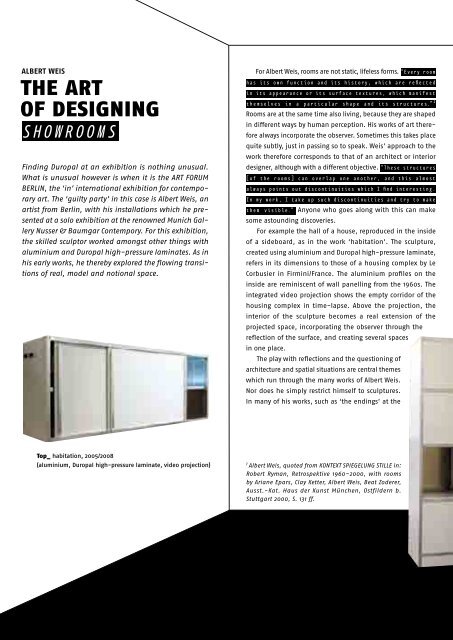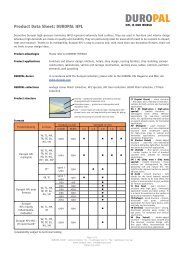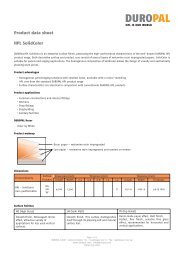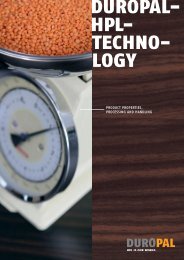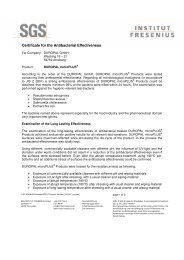You also want an ePaper? Increase the reach of your titles
YUMPU automatically turns print PDFs into web optimized ePapers that Google loves.
ALBERT WEIS<br />
<strong>THE</strong> ART<br />
OF DESIGNING<br />
SHOWROOMS<br />
Finding <strong>Duropal</strong> at an exhibition is nothing unusual.<br />
What is unusual however is when it is the ART FORUM<br />
BERLIN, the ‘in’ international exhibition for contemporary<br />
art. The ‘guilty party’ in this case is Albert Weis, an<br />
artist from Berlin, with his installations which he presented<br />
at a solo exhibition at the renowned Munich Gallery<br />
Nusser & Baumgar Contempory. For this exhibition,<br />
the skilled sculptor worked amongst other things with<br />
aluminium and <strong>Duropal</strong> high-pressure laminates. As in<br />
his early works, he thereby explored the flowing transitions<br />
of real, model and notional space.<br />
Top_ habitation, 2005/2008<br />
(aluminium, <strong>Duropal</strong> high-pressure laminate, video projection)<br />
For albert Weis, rooms are not static, lifeless forms. “Every room<br />
has its own function and its history, which are reflected<br />
in its appearance or its surface textures, which manifest<br />
themselves in a particular shape and its structures.” 1<br />
rooms are at the same time also living, because they are shaped<br />
in different ways by human perception. His works of art there-<br />
fore always incorporate the observer. Sometimes this takes place<br />
quite subtly, just in passing so to speak. Weis’ approach to the<br />
work therefore corresponds to that of an architect or interior<br />
designer, although with a different objective. “These structures<br />
[of the rooms] can overlap one another, and this almost<br />
always points out discontinuities which I find interesting.<br />
In my work, I take up such discontinuities and try to make<br />
them visible.” anyone who goes along with this can make<br />
some astounding discoveries.<br />
For example the hall of a house, reproduced in the inside<br />
of a sideboard, as in the work ‘habitation’. the sculpture,<br />
created using aluminium and duropal high-pressure laminate,<br />
refers in its dimensions to those of a housing complex by Le<br />
Corbusier in Firmini/France. the aluminium profiles on the<br />
inside are reminiscent of wall panelling from the 1960s. the<br />
integrated video projection shows the empty corridor of the<br />
housing complex in time-lapse. above the projection, the<br />
interior of the sculpture becomes a real extension of the<br />
projected space, incorporating the observer through the<br />
reflection of the surface, and creating several spaces<br />
in one place.<br />
the play with reflections and the questioning of<br />
architecture and spatial situations are central themes<br />
which run through the many works of albert Weis.<br />
Nor does he simply restrict himself to sculptures.<br />
in many of his works, such as ‘the endings’ at the<br />
1 Albert Weis, quoted from KONTEXT SPIEGELUNG STILLE in:<br />
Robert Ryman, Retrospektive 1960–2000, with rooms<br />
by Ariane Epars, Clay Ketter, Albert Weis, Beat Zoderer,<br />
Ausst.-Kat. Haus der Kunst München, Ostfildern b.<br />
Stuttgart 2000, S. 131 ff.


